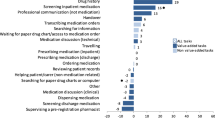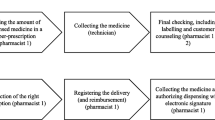Abstract
Purpose
Integrated electronic prescribing systems (IEPSs) are expected to improve efficiency and safety in the management of pharmaceuticals throughout the healthcare sector. In Sweden (population 9 million), more than 25 million e-prescriptions each year are processed in the National IEPS. We set out to examine the introduction of an IEPS into pharmacists’ practice with regard to impact on work efficiency and pharmacological safety.
Methods
A questionnaire was distributed to all pharmacists (n = 74) in a Swedish municipality (population 145,000), where an IEPS had recently been introduced. The response rate was 70%.
Results
The IEPS was in general perceived to have expedited the processing of prescriptions and reduced the risk for prescription errors as well as the handing over of erroneous medications to patients. We found that there was a positive correlation between usefulness of the IEPS system for work efficacy and pharmacological safety, respectively (r =0 .524, p < .001) and a negative correlation between the usefulness of the IEPS for work efficacy and perception of barriers to technology use (r = −0.010, p > 0.05). We also found that there was a negative correlation between IEPS usefulness for pharmacological safety and that barriers to IEPS technology use were experienced (r = 0.031, p > 0.05).
Conclusions
The results indicate that reduction of system unavailability due to technical issues will increase the perceived usefulness of IEPSs for pharmacists with regard to both work efficacy and pharmacological safety. We conclude that the introduction of an IEPS was well received by pharmacists; however, barriers to full acceptance remained, in particular, system unavailability due to technical problems.




Similar content being viewed by others
References
Tamblyn R, Huang A, Kawasumi Y, Bartlett G, Grad R, Jacques A et al (2006) The development and evaluation of an integrated electronic prescribing and drug management system for primary care. J Am Med Inform Assoc 13(2):148–159
Kohn LT, Corrigan JM, Donaldson MS (2000) To err is human: building a safer health system. National Academy, Washington, D.C
Kongkaew C, Noyce PR, Ashcroft DM (2008) Hospital admissions associated with adverse drug reactions: a systematic review of prospective observational studies. Ann Pharmacother 42(7):1017–1025
Miasso AI, Oliveira RC, Silva AE, Lyra Junior DP, Gimenes FR, Fakih FT et al (2009) Prescription errors in Brazilian hospitals: a multi-centre exploratory survey. Cad Saúde Pública 25(2):313–320
Seiving B, Hallberg M (2001) The Helsingborg Model – The joint competence pilot project
Mjörndal T, Boman MD, Hägg S, Bäckström M, Wiholm BE, Wahlin A, Dahlqvist R (2002) Adverse drug reactions as a cause for admissions to a department of internal medicine. Pharmacoepidemiol Drug Saf 11(1):65–72
Helldén A, Bergman U, von Euler M, Hentschke M, Odar-Cederlöf I, Ohlén G (2009) Adverse drug reactions and impaired renal function in elderly patients admitted to the emergency department: a retrospective study. Drugs Aging 26(7):595–606
Erecept Stockholm 2009; Available at: http://www.ereceptstockholm.se/imcms/servlet/GetDoc?meta_id=1011, 2009
Baldauf-Sobez W, Bergstrom M, Meisner K, Ahmad A, Häggström M (2003) How Siemens’ computerized physician order entry helps prevent the human error. Electromedica 71(1):1–9
Miller RA, Gardner RM, Johnson KB, Hripcsak G (2005) Clinical decision support and electronic prescribing systems: a time for responsible thought and action. J Am Med Inform Assoc 12(4):403–409
Ammenwerth E, Schnell-Inderst P, Machan C, Siebert U (2008) The effect of electronic prescribing on medication errors and adverse drug events: a systematic review. J Am Med InformAssoc 15(5):585–600
Astrand B, Montelius E, Petersson G, Ekedahl A (2009) Assessment of ePrescription quality: an observational study at three mail-order pharmacies. BMC Med Inform Decis Mak Vol. 9, No. 8
Montelius E, Astrand B, Hovstadius B, Petersson G (2008) Individuals appreciate having their medication record on the web: a survey of attitudes to a national pharmacy register. J Med Internet Res 11(4):e35
Fishbein M, Ajzen I (1975) Belief, attitude, intention and behavior: an introduction to theory and research. Addison-Wesley, Reading
Davis FD (1989) Perceived usefulness, perceived ease of use, and user acceptance of information technology. MIS Q Manage Inf Syst 13(3):319–339
Wu J, Shen W, Lin L, Greenes RA, Bates DW (2008) Testing the technology acceptance model for evaluating healthcare professionals' intention to use an adverse event reporting system. Int J Qual Health Care 20(2):123–129
Schaper LK, Pervan GP (2007) ICT and OTs: a model of information and communication technology acceptance and utilisation by occupational therapists. Int J Med Inform 76(1):212–221
King WR, He J (2006) A meta-analysis of the technology acceptance model. Inf Manage 43(6):740–755
Yarbrough AK, Smith TB (2007) Technology acceptance among physicians: a new take on TAM. Med Care Res Rev 64(6):650–672
Åstrand B, Hovstadius B (2009) Elektronisk recepthantering. [Management of electronic prescriptions] In: Läkemedelsboken. Stockholm: Apoteket AB: 1281–1283. [In Swedish]
Brender J (2006) Handbook of evaluation methods for health informatics. Elsevier Academic, Amsterdam
American Academy of Pediatrics Council on Clinical Information Technology, Gerstle RS (2007) Electronic prescribing systems in pediatrics: the rationale and functionality requirements. Pediatrics 119(6):1229–1231
Barber N, Cornford T, Klecun E (2007) Qualitative evaluation of an electronic prescribing and administration system. Qual Saf Health Care 16(4):271–278
Rahimi B, Timpka T, Vimarlund V, Uppugunduri S, Svensson M (2009) Organization-wide adoption of computerized provider order entry systems: a study based on diffusion of innovations theory. BMC Med Inform Decis Mak 9:52
Upperman JS, Staley P, Friend K, Neches W, Kazimer D, Benes J et al (2005) The impact of hospitalwide computerized physician order entry on medical errors in a pediatric hospital. J Pediatr Surg 40(1):57–59
Rahimi B, Moberg A, Timpka T, Vimarlund V (2008) Implementing an integrated computerized patient record system: Towards an evidence-based information system implementation practice in healthcare. AMIA Annu Symp Proc: 616–620
Rahimi B, Vimarlund V, Timpka T (2008) Health Information system implementation: A qualitative meta-analysis. J Med Syst: 1–10
Murff HJ, Kannry J (2001) Physician satisfaction with two order entry systems. J Am Med Inform Assoc 8(5):499–509
Wong IC, Wong LY, Cranswick NE (2009) Minimising medication errors in children. Arch Dis Child 94(2):161–164
Acknowledgment
We thank Rahman Mokhtari (pharmacist) and Mr. Naser Sheikhi, M.Sc. for their support in distributing the questionnaire and the statistical analysis. We also thank Professor Vivian Vimarlund.
Author information
Authors and Affiliations
Corresponding author
Rights and permissions
About this article
Cite this article
Rahimi, B., Timpka, T. Pharmacists’ views on integrated electronic prescribing systems: associations between usefulness, pharmacological safety, and barriers to technology use. Eur J Clin Pharmacol 67, 179–184 (2011). https://doi.org/10.1007/s00228-010-0936-9
Received:
Accepted:
Published:
Issue Date:
DOI: https://doi.org/10.1007/s00228-010-0936-9




